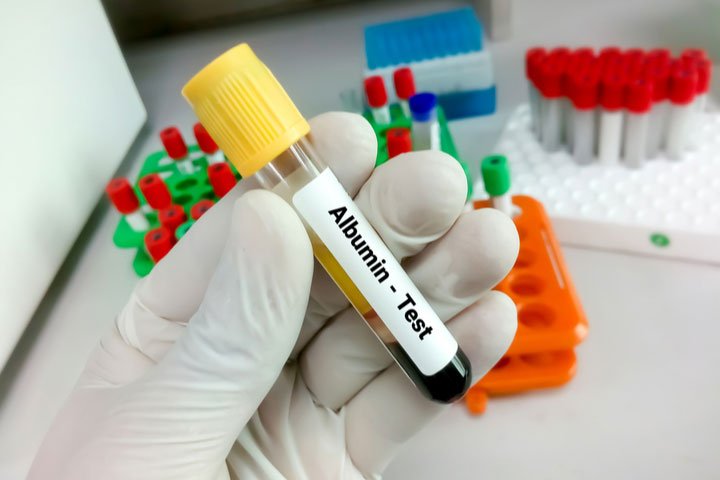- Home
-
Test Categories
- Diabetes
- Urinary
- Thyroid
- RTPCR
- Genetic
- Cancer
- Haematology
- Biochemistry
- Serology & Immunology
- Clinical Pathology
- Cytology
- Microbiology
- Endocrinology
- Histopathology
- MOLECULAR DIAGNOSTICS
- Pregnancy(Biochemistry)
- Liver
- Prostate
- Fertility
- Gastro
- Autoimmune Disorders
- Heart
- Kidney
- Vitamins
- Tuberculosis (TB)
- Anemia
- Fever
- Allergy
- Blood Tests Rare
- Profiles
- Packages
- About Us
- Why Choose Us
- Upload Prescription
- Corporate Wellness
- Contact Us

-
Overview
Albumin is a vital protein produced by the liver, playing an essential role in maintaining the body's fluid balance, transporting hormones, vitamins, and drugs, and providing the body with proteins that aid in tissue growth and repair. An albumin test measures the level of albumin in the blood and is often used to evaluate liver function, kidney health, and overall nutritional status. Abnormal albumin levels can indicate various health conditions, including liver disease, kidney disorders, inflammation, or malnutrition.
Patient Preparation for Albumin Test
- Fasting Requirements:
- Fasting: Not required. Patients do not need to fast before an albumin test. They can eat and drink as usual unless specifically instructed otherwise by their healthcare provider.
- Other Preparations:
- Medications: No special medication adjustments are needed unless specified by a healthcare provider.
- Hydration: It is advisable for patients to stay well-hydrated to facilitate easier blood draw.
- Avoid Strenuous Activities: Avoid intense physical activity before the test as it can temporarily alter albumin levels.
Blood Sample Collection by Speediagno Phlebotomist:
Speediagno employs highly trained phlebotomists who follow professional and standardized procedures for blood collection to ensure patient comfort, accuracy, and safety.
Preparation for Blood Collection:
- Identify the Patient: The phlebotomist confirms the patient’s identity using at least two identifiers (e.g., name and date of birth).
- Consent: Obtains consent from the patient and explains the procedure briefly to make them comfortable.
- Gather Supplies: The phlebotomist prepares all necessary equipment, including gloves, alcohol swabs, a tourniquet, sterile needles, collection tubes, and bandages.
Blood Collection Process:
- Hand Hygiene: The phlebotomist performs hand hygiene before and after the procedure.
- Position the Patient: The patient is seated comfortably with their arm extended and relaxed.
- Tourniquet Application: A tourniquet is applied around the upper arm to make the veins more prominent and easier to locate.
- Vein Selection and Cleansing: A suitable vein is selected, usually in the antecubital fossa (inner elbow), and the area is cleansed with an alcohol swab in a circular motion to prevent infection.
- Needle Insertion: A sterile needle is carefully inserted into the vein at the appropriate angle. Blood is drawn into the collection tube smoothly and steadily.
- Tube Mixing: The blood collection tube is gently inverted several times if required (for certain types of tests) to mix any anticoagulants.
- Removing the Needle and Applying Pressure: Once the blood draw is complete, the needle is removed, and a cotton ball or gauze is immediately applied with gentle pressure to prevent bleeding.
- Bandaging: The puncture site is bandaged to protect it and reduce the risk of bruising.
Post-Collection Care:
- Dispose of Sharps Properly: All needles and other sharps are disposed of in a designated sharps container following safety protocols.
- Label the Sample: The collected sample is labeled accurately with the patient’s details to prevent errors during analysis.
- Provide Post-Procedure Instructions: Patients are advised to avoid heavy lifting with the affected arm for a few hours and to report any unusual symptoms like prolonged bleeding or dizziness.
Sample Transport:
- The blood sample is then transported promptly to the laboratory under controlled conditions, ensuring it reaches the lab in optimal condition for analysis.
This professional approach by Speediagno ensures a safe, efficient, and comfortable experience for patients while maintaining high standards of quality and accuracy in the test results.
All test groups and subgroup
-
Albumin
